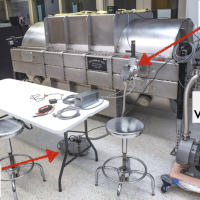HPF

The Habitable Zone Planet Finder, or HPF, was installed on the 10-meter Hobby-Eberly Telescope at McDonald Observatory in Texas. It is an astronomical spectrograph currently being commissioned as a facility instrument for the HET.
Conceptual drawing of the HPF spectrograph in the vacuum chamber. The top of the vacuum chamber has been removed to show the spectrograph optics.
Conceptual drawing of the HPF spectrograph in the vacuum chamber. The top of the vacuum chamber has been removed to show the spectrograph optics.
HPF will search for exoplanets by using the Doppler effect. As a planet orbits its star, it exerts a tiny gravitational pull on the star, causing the star to “wobble.” Just as a moving siren causes the pitch heard by a stationary observer to change, the star’s motion causes the absorption lines in its spectrum to shift in wavelength very slightly. An excellent animation of the effect may be seen here.
The HPF spectrograph will target small, cool stars called M dwarfs. These stars emit most of their light at infrared wavelengths, so HPF will be optimized to detect near-infrared light. One of the challenges for an infrared spectrograph is the background radiation from the instrument itself. At room temperature, the materials in the instrument radiate so much infrared light that any starlight would be completely overwhelmed! To remedy this problem, HPF will be placed in a vacuum chamber and cooled to 180 Kelvin (-93 degrees Celsius, or -136 degrees Fahrenheit).
Our current understanding of biology and planetary physics suggests that in order to be habitable, a planet must be a rocky planet, like the inner planets of the Solar system. Such planets have low masses, and therefore the stellar Doppler signals from them will be small. For M dwarfs, the signals are larger than for stars like the Sun because the stars themselves are less massive, but we still need to be able to measure their motions to a precision of about 1 meter per second–roughly walking speed for humans. Placing HPF in a vacuum chamber at constant temperature helps achieve the needed precision, as changes in air pressure or temperature can alter our measured wavelengths.
For more information, see the HPF blog.
Source: http://hpf.psu.edu/what-is-hpf/




